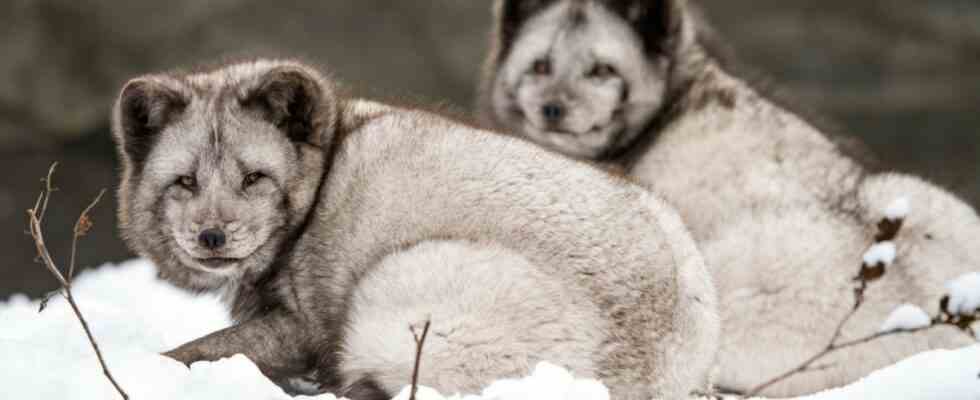When it gets cold, the animals shouldn’t just be warm, they also need to be protected from rain, snow and wind. Because some residents of the Hellabrunn Zoo are quite sensitive when it comes to the weather. That’s why the thermostats in the facilities, such as the elephant house or the jungle house, are not turned on, explains spokeswoman Sophia Zimmerling. In the zoo, saving energy is the task of the employees – not the animals.
cuddle up warm
Meerkats are social animals and look out for one another.
(Photo: Marc Müller/Hellabrunn Zoo)
The four meerkats warm themselves under a red light lamp. They cuddle not only to keep warm, but also to maintain physical contact. Because they are very social animals. The colony takes care of sick or injured conspecifics, they are given special protection. Thanks to their team spirit, they survive in the wild. While some are busy digging and digging under the ground, others are on the lookout for enemies.
But you shouldn’t underestimate the long little animals: meerkats belong to the order of predators, the mongoose family. They are related to the martens. They prefer to eat insects. In the wild, scorpions, lizards and eggs are also on the menu.
Chic fur
If need be, the European wolf can also be snowed in properly.
(Photo: Birgit Mohr/Hellabrunn Zoo)
Resting on the leaves and enjoying the last rays of sunshine: The three young wolves from Riga have been in Hellabrunn since spring and, after major renovations, now have a shelter, a bathing bay and trees to play and climb. Cold temperatures hardly bother wolves, they are so well insulated with their winter fur that even the snow stays on them. So they can be snowed in – like last time in February. European wolves change their fur twice a year. The thick, dense and insulating winter coat builds up from August to October. It then falls again in April, revealing the short, much thinner summer coat.
The situation is similar with arctic foxes: Vulpes lagopus, the “rabbit-footed fox”, has paws covered with thick fur. That’s why they can walk on loose snow without sinking. The arctic foxes have three coats on: Under the winter coat they wear a thick undercoat and a long top coat.
cozy home
Alpine marmots breathe only twice a minute during hibernation.
(Photo: Birgit Mohr/Hellabrunn Zoo)
The Alpine marmots retreat into their cozy burrow to hibernate during the cold season. In order to minimize their energy expenditure, they then only breathe about twice a minute. Their conspecifics in the wild have a harder time, because climate change is also having an impact on them: the marmots are already reacting sensitively to an average of two degrees more, which is why they are found in the Alps at higher altitudes. However, the humus layer is thin there. They can hardly dig deep burrows for hibernation.
The marmot families live in the deep, widely branched structures. This is where life happens: They mate, give birth to their young and just hibernate. They put a lot of effort into it: in summer, marmots let grass dry in the sun to make hay. This makes your building a cozy home in winter. A family collects up to ten kilograms of hay, everything for their warm and soft winter quarters.
Off to the south
The northern bald ibis overwinters in Hellabrunn – only some young birds come into the European Conservation Breeding Program and learn to migrate south.
(Photo: Marc Müller/Hellabrunn Zoo)
Some birds in the large aviary move to their winter quarters in late autumn. These more sensitive species overwinter in a heated house attached to the aviary. The animal keepers put out the food there. The northern bald ibis, for example, is actually a migratory bird, but some of the Hellabrunn specimens remain in the zoo over the winter. But some young birds come into the European Conservation Breeding Program and learn to fly south, accompanied by microlight aircraft.
warm bath
Siberian tigers love to swim – even in winter.
(Photo: Gemma Borrell/Hellabrunn Zoo)
As soon as the leaves fall, the zoo checks the water pumps and heating technology in the systems. The pumps ensure that the streams and waterfalls remain ice-free. This is especially beneficial for the Siberian tiger, because it loves to swim.
The Humboldt penguins don’t do much with ice-cold water temperatures. They live mainly off the coasts of Peru and Chile, in the Humboldt Current. The penguins have adapted to the South American warmth, their layer of fat is not as thick as that of their relatives living in the South Pole.
save energy
Even if the animals cannot contribute anything, the energy crisis is not leaving Hellabrunn unscathed either. In the coming winter, employees should save where they can. This affects, for example, the administration building and workshops, says spokeswoman Zimmerling. She can’t say exactly how much cooler it will be this winter, only this much: Work is being done as energy-efficiently as possible.
There is no jittering in the animal enclosures – too stressful for the residents, says the spokeswoman. “We can’t put scarves on our female giraffes and then leave them out in the cold.” In the elephant house, for example, the temperature is always around 20 degrees. The water temperature in the aquarium is also not turned down for the sake of animal welfare. From next summer, the zoo should be CO₂-neutral. Then, according to the spokeswoman, it will be supplied with geothermal energy from a power plant operated by Stadtwerke München.

